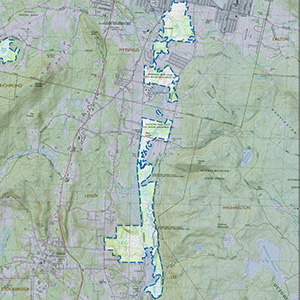Important Bird Area Sites in Massachusetts
Important Bird Area: Upper Housatonic Valley
Site Summary
Nominated By
René Laubach
Size
1,300 acres
Towns and Counties
Lee, Lenox, Pittsfield; Berkshire
Ownership
MassWildlife, municipal, Mass Audubon
Major Habitats
30% emergent freshwater wetland, 22% river/stream, 12% scrub-shrub wetland, 9% palustrine woodland swamp, 8% cultural grassland, 5% early successional shrubland, 5% oak-conifer transition forest, 5% lake/pond, 3% cultivate field
Land Use
wildlife conservation, hunting/fishing, agriculture, utility/right of way
IBA Criteria
- Category 1: Sites important for long-term research and/or monitoring projects that contribute substantially to ornithology, bird conservation, and/or education.
- Category 2: Sites containing assemblages of species characteristic of a representative, rare, threatened, or unique habitat within the state or region.
- Category 4: Sites regularly holding significant numbers of species of high conservation priority in Massachusetts.
- Category 5: Sites regularly holding significant numbers of an endangered, threatened, vulnerable, or declining species.
Site Description
Approximately 1,300 acres of riparian woodland, oxbow ponds, marshes, beaver swamps, grasslands, and upland woods along the meandering Housatonic River, this IBA represents some of the finest riparian habitat remaining in central Berkshire County. The area is comprises MassAudubon's 262-acre Canoe Meadows Wildlife Sanctuary in Pittsfield at the northern end of the proposed IBA; the 816-acre Housatonic River Valley Wildlife Management Area, south of Canoe Meadows, extending from Pittsfield to Lenox and Lee; and the 200-acre Post Farm, the site of a former Lenox town dump, currently managed by the Lenox Conservation Commission and abutting the Wildlife Management Area at its southern end. Canoe Meadows was established in 1975, the Housatonic Valley Wildlife Management Area was established in 1968, and Post Farm was established in the early 1980s. More than 200 species of birds have been recorded at the combined areas since 1970. The Housatonic is the major river of the Berkshires and flows almost 150 miles from its three sources near Pittsfield to Long Island Sound. The river valley is underlain by calcareous bedrock, and it is the alkaline properties of the soils created that give rise to numerous unusual species of flora and fauna. The area is bordered immediately to the east by the 16,000-acre October Mountain State Forest and several thousand acres of city of Pittsfield watershed land. This riparian corridor serves as a breeding habitat for numerous wetland species, as well as serving as a migration corridor for many other species of birds.
Current Conservation Status
There is currently a broad-based effort underway to designate the Upper Housatonic River Valley region (Pittsfield to northwestern Connecticut) as a national heritage area (similar to the Blackstone River Valley) by the US National Park Service (USNPS). The proposed IBA falls within this potential Corridor. Recommendation by USNPS to Congress is thought to be very likely. River-bottom sediments in the Housatonic in this area contain very high levels of polychlorinated biphenyls (PCBs). This polymer was manufactured by General Electric and released into the environment for decades in Pittsfield prior to being outlawed in 1972 by the Environmental Protection Agency (EPA). This cancer-causing substance bioaccumulates in the fatty tissues of animals that feed on prey found in or near contaminated sediments. Scientific tests conducted by consultants for the EPA have found extremely high PCB levels in the tissues of animals present including dabbling ducks such as American Black Duck, The Tree Swallow, and other vertebrates. Another threat to the ecological integrity of this area is the spread of exotic invasive plants (notably Purple Loosestrife) within the Housatonic's floodplain communities.
Ornithological Significance
Up to several pairs of the state-endangered American Bittern breed in the area annually. A special concern species, the Common Moorhen is an uncommon though regular breeder in the area. Other high conservation priority species represented by at least 25 breeding pairs include: American Black Duck, American Woodcock, Hairy Woodpecker, Eastern Wood-Pewee, Alder Flycatcher, Least Flycatcher, Great Crested Flycatcher, Eastern Kingbird, Veery, Chestnut-sided Warbler, American Redstart, Indigo Bunting, and Rose-breasted Grosbeak. Although numbering fewer than 25 pairs, one of the few Cliff Swallow colonies in Berkshire County is located under the New Lenox Road bridge. In addition, the following species with more than 1 percent of their entire breeding population within Massachusetts breed in the area: Eastern Phoebe, Wood Thrush, Gray Catbird, Blue-winged Warbler, Scarlet Tanager, and Baltimore Oriole. Riparian Forest is present along this portion of the Housatonic River. Characteristic breeding bird species of this vanishing habitat include: Wood Duck, Hooded Merganser, Warbling and Yellow-throated Vireos, Veery, and Blue-gray Gnatcatcher. Rare and/or declining species representative of extensive freshwater marshlands that breed on the area include: American Bittern, Sora, Virginia Rail, King Rail, and Common Moorhen. The site is a migration corridor for the Common Nighthawk.
Other Flora or Fauna of Significance
A breeding population of Wood Turtle a species of special concern in Massachusetts, occurs in the area. Canoe Meadows Wildlife Sanctuary contains certified vernal pools where spotted salamanders breed. The Northern Leopard Frog also occurs there. A number of state-listed plant species have been recorded at Canoe Meadows Wildlife Sanctuary including Bristly Buttercup, and White Adder's-mouth. All three state sites of Wapato are located in the wildlife management area. Foxtail Sedge, a plant listed as threatened in the state, has been found at one site on the IBA.
Data Sources
Hendricks, Bartlett. 1999. Berkshire Birds. Third ed. The Berkshire Museum. 75 pp.
Laubach, René. 1999. Canoe Meadows Wildlife Sanctuary. Bird Observer. pp. 324-331.
Perkins, Simon. 2000. A Checklist of the Birds, Canoe Meadows Wildlife Sanctuary. Mass Audubon.
Robinson, Scott and Joan Robinson. 2001. The Pittsfield Nighthawk Watch: 1993-2001. Bird Observer pp. 446-447.
St. James, David P. 1986. Birds of the Housatonic Wildlife Management Area (checklist). MassWildlife. 1993.
Birding the Housatonic Valley Wildlife Management Area. Bird Observer pp. 76-84. 1999.
Wetland Specialties in Berkshire County. Bird Observer. pp. 313-316.
Veit, Richard R. and Wayne R. Petersen. 1993.Birds of Massachusetts. Mass Audubon. 514 pp.




